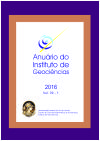Geoprocessing Applied to the Determination of Susceptibility Index Funding for Tubular Wells of the Serra Geral System in Frederico Westphalen -- Rio Grande do Sul
DOI:
https://doi.org/10.11137/2016_3_79_88Keywords:
Groundwater, Contamination, POSH.Abstract
The issue related to the contamination of the superficial and underground water resources, associated to the lack of environmental monitoring, instigates researchers and professionals to seek new information and methods to promote a proper management. Thus, searching for a better understanding of the susceptibility to contamination of groundwater resources in the city of Frederico Westphalen -RS, Rio Grande do Sul, Brazil, and its potential sources of contamination. This work combines the methodologies of Susceptibility Index (IS) with the Pollutant Origin Surcharge Hydraulically (POSH) system through geoprocessing tools. For this, it has built up a database of hydrogeological information based on System Groundwater Information (SIAGAS) from the Geological Service of Brazil, to the depth parameters of water level and the material of the aquifer. Also, there has been raised information of relief and land use from the images provided by the United States Geological Survey (USGS). From this information, we determined the IS and applied the POSH method for the determination of potential sources of pollution load generation from the local aquifer. The results showed an IS ranging from low to very low in 14% of the city, moderately low in 55%, moderate high at 30% and higher by 1%, with the largest classes found east of the city mainly in the areas of agricultural crops subsistence. The use of POSH method indicated that the potential sources of contaminant load generation are located in areas of moderate to high susceptibility to contamination. These being areas more susceptible to contamination from diffuse sources, depending on annual crops of surface and groundwater sources. Therefore, it was concluded that the geoprocessing techniques applied in the relationship between the IS and POSH, optimize the identification of potential sites and sources of groundwater pollution, being useful in monitoring and environmental planning.
Downloads
Downloads
Published
How to Cite
Issue
Section
License
This journal is licensed under a Creative Commons — Attribution 4.0 International — CC BY 4.0, which permits use, distribution and reproduction in any medium, provided the original work is properly cited.















